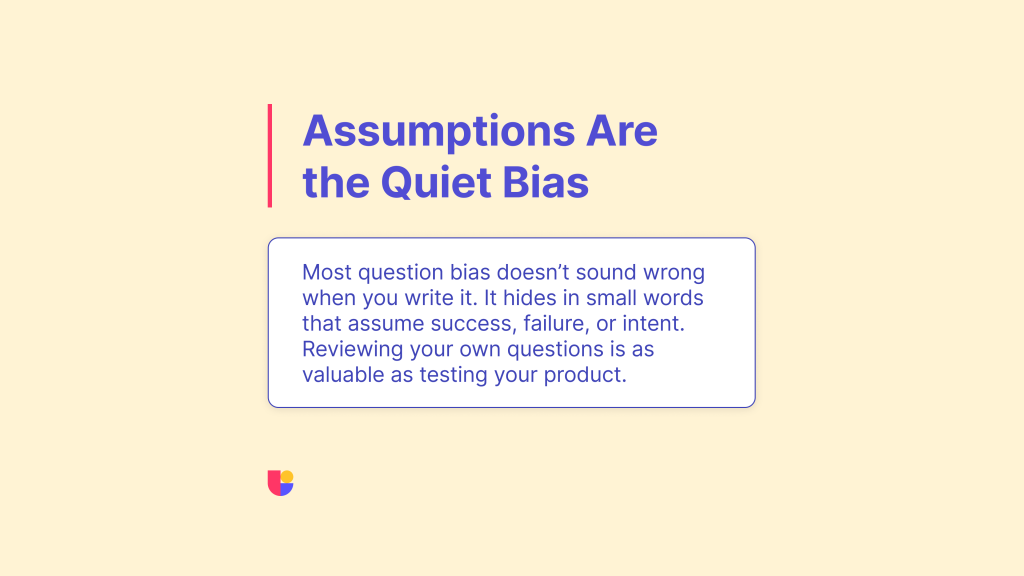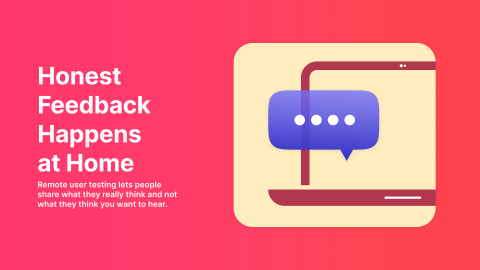The quality of your research depends on the questions you ask. Whether you are running a usability test or a short survey, the way you phrase your user testing questions determines the quality of your insights. A leading or confusing question can skew the results of an entire study. And when that happens, you don’t just lose data, you lose clarity and time (and if you don’t catch the mistake in time, you might even go down the wrong design path).
At Useberry, we see one pattern across every successful survey (besides using our Questions Block): the best insights come from well-written questions. Whether you are running a usability test or a quick survey, the way you phrase your user testing questions determines the quality of your insights.
Let’s look at what makes a user testing question effective, what makes it misleading, and how to phrase questions that reveal what people actually think and do.
Why Questions Matter More Than We Think
We often spend hours designing flows and prototypes but only minutes on the questions we’ll ask about them. Yet those questions are the bridge between what users experience and what we learn from it.
The difference between “Would you use this feature?” and “When might you use this feature?” seems small but leads to very different answers.
The first invites can only get a yes or no (which might be all you need in some cases) with no context while the second lets you learn about real use cases.
What Makes a User Testing Question Effective
Strong user testing questions share three core traits: clarity, neutrality, and focus.
Clarity
Avoid internal product language or phrasing that assumes users know your terminology. Instead of asking, “How do you feel about the multi-account onboarding interface?” try “Was it easy to add another account?” People can only answer what they actually understand.
Neutrality
Keep questions open and balanced. Even small word choices influence tone.
Compare these two:
- How easy was it to find what you needed?
- How difficult was it to find what you needed?
Both seem harmless, but the first assumes success while the second assumes failure. A more neutral version is:
- How would you describe your experience finding what you needed?
Focus
Ask one thing at a time. Something like “Did you find the product helpful and affordable?” mixes two questions into one. If the participant says no, you don’t know which part failed. Keep it clean and specific. One question, one answer. You should try to avoid double-barrel questions as much as possible.

When Good Intentions Go Wrong
Even experienced researchers can make small wording mistakes that snowball into misleading results.
- Leading questions:
Asking “How much did you like this layout?” assumes the layout is likable. Try “What’s your opinion of this layout?” or “What stood out to you about this layout?”
- Loaded questions:
Phrasing like “Why did you ignore the checkout button?” adds judgment. Replace it with “What made you decide not to continue to checkout?”
- Assumptive questions:
Avoid phrasing that presumes what participants did during the test. For example, in a remote study you might be tempted to ask, “When did you notice the offer banner?” or “After you finished the signup, what did you think of the confirmation page?”
But those questions assume both actions happened. Some users might have missed the banner or never completed the signup flow. Instead, ask more neutral follow-ups such as: “Did you notice any promotional elements on the page?” or “What happened after you clicked sign up?”

Examples from Real User Testing Studies
Small changes in phrasing can make a big difference in the quality of your insights.
| Weak Question | Better Version | Why It Works |
|---|---|---|
| Would you use this feature? | When (or why) would you use this feature? | Prompts real-life context, not yes/no. |
| Did you find the process simple? | How did the process feel to you? | Encourages emotional and descriptive feedback without assumptions. |
| Was the form confusing? | What part of the form, if any, felt unclear? | Reduces bias and invites nuance. |
| How much do you like this version? | Which version communicates the goal better? | Shifts focus from preference to purpose. |
These examples show how thoughtful phrasing transforms a remote user testing study from a checklist into a real conversation.
Different Studies, Different Question Styles
Each type of study benefits from a slightly different tone and structure.
Usability Tests
Focus on actions and decision-making:
- “Where would you click to start?”
- “What do you expect to happen next?”
- “How confident do you feel completing this step?”
Preference Tests
Focus on comparison and reasoning:
- “Which version communicates better what this product does?”
- “Which one feels more trustworthy to you, and why?”
Surveys and Post-Task Questions
Go for clarity and emotion.
- “What stopped you from completing this task?”
- “What was most helpful (or least helpful) while completing this task?”
Avoiding Common Pitfalls
Before launching any study, read your own user testing questions out loud. You will hear where bias or confusion creeps in. Run a small pilot or if you’re working with a team, ask someone outside the project to review your questions. They will catch assumptions that you have stopped noticing.
For more practical advice on writing unbiased and effective research questions, Nielsen Norman Group’s guide on Writing Good Survey Questions is also a great reference to keep handy.
Consider ending your study with one open-ended question when it makes sense. It gives participants space to share thoughts you might not have anticipated and sometimes those spontaneous answers surface insights that structured questions miss.
If you’d rather not reinvent your questionnaire each time, check out our ready-made feedback survey templates. These tailor made templates will help you avoid some of the common mistakes we just covered before they can come up.
How This Fits into Better Research

Asking effective user testing questions is a skill that grows with practice. It helps researchers uncover patterns instead of just opinions, and it helps designers and marketers translate feedback into action.
This approach aligns closely with how we see UX research evolving at Useberry: simpler, faster, and closer to real user behavior. When you focus on clarity, neutrality, and purpose, you get insights you can trust. If you’d like to explore how to interpret those insights more deeply, take a look at our article From Clicks to Context: How to Measure What Users Actually Feel.
Ask the Right Questions, Get the Right Insights
Start testing with Useberry




